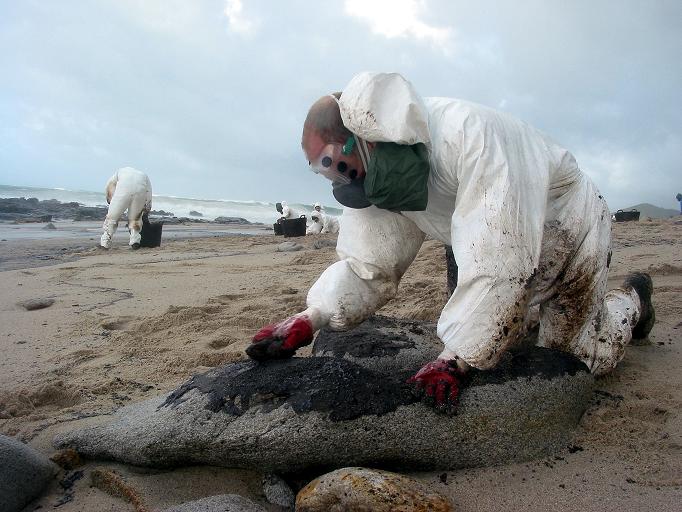An experiment carried out on rodents exposed to fuel similar to that of the Prestige tanker oil spill concluded that inhalation of the fuel causes damage to genetic material. They say the results could be used to help people who carry out the industrial cleaning of coasts.
A team of researchers from the University of A Coruña carried out an experiment using two different strains of rat and a respiratory chamber especially designed to create fuel exposure. For two hours a day, five days a week, the animals were exposed to a fuel similar in composition to that of the Prestige oil spill.

Prestige oil spill. Credit : Stephane M Grueso
"Induced damage to genetic material and the development of different respiratory ailments has been previously been seen in people who took part in the oil spill cleanup effort," Vanessa Valdiglesias, researcher at the Toxicology Unit of the University of A Coruña, told Servicio de Información y Noticias Científicas (SINC). Along with the Institute of Biomedical Research of A Coruña, they had already tried to describe the effects of the oil spill on people's health with little success.
The new study of rats found a direct link between respiratory exposure to compounds discharged by the fuel and damage to genetic material. In order to analyze the possible alterations to the DNA and its repair processes, the researchers took blood samples from each animal and carried out cytogenic tests. The results were that exposure to fuel through inhalation causes damage to the DNA of both types of rat - both of which differed in susceptibility to the compounds of the fuel - and also alters DNA repair processes.
The research group looked at oxidative damage, with the aim of guiding decisions regarding diagnosis and therapy in the care of those affected by fuel exposure, whatever the circumstances. "This involves those professionals carrying out their occupational duty in extraction wells, refineries, petrol stations etc, as well as those who aid the cleanup efforts following oil spills," said Valdiglesias.
In her opinion, the easiest way to avoid damage is to follow the instructions given by the professionals when it comes to the protective gear, which should be worn at all times during cleanup.
Citation: Valdiglesias, Vanessa; Kilic, Gözde; Costa, Carla; Amor-Carro, Oscar; Mariñas-Pardo, Luis; Ramos-Barbón, David; Méndez, Josefina; Pásaro, Eduardo; Laffon, Blanca. "In vivo genotoxicity assessment in rats exposed to Prestige-like oil by inhalation" Journal of Toxicology and Environmental Health-part A-current issues 75. Pages: 756-764 DOI: 10.1080/15287394.2012.689801, 2012.





Comments